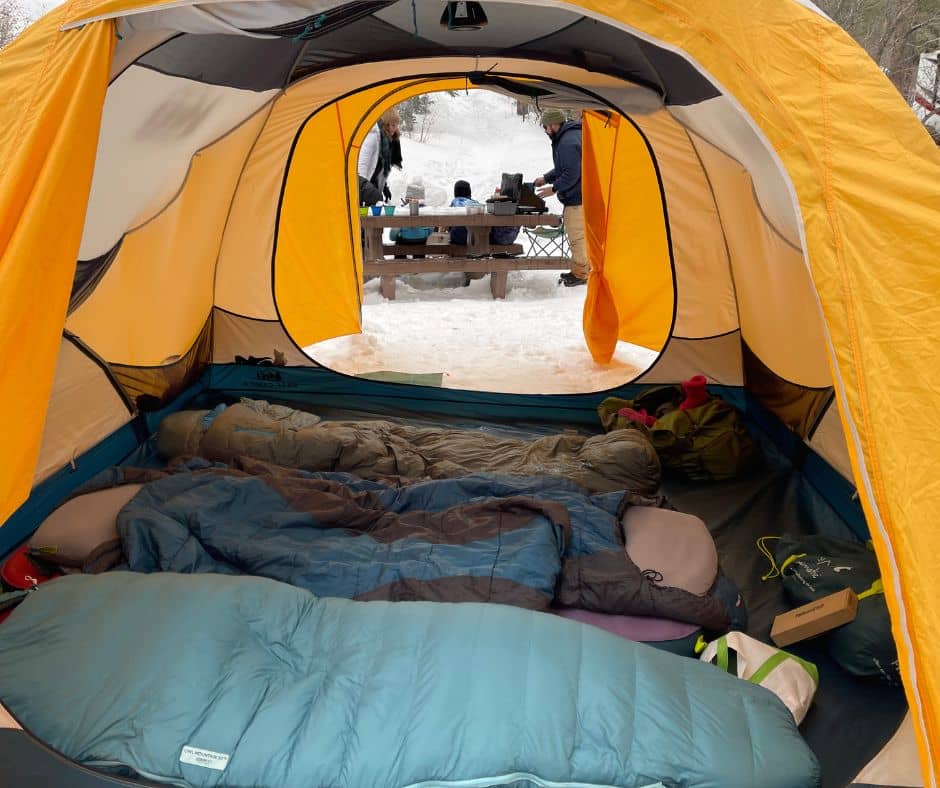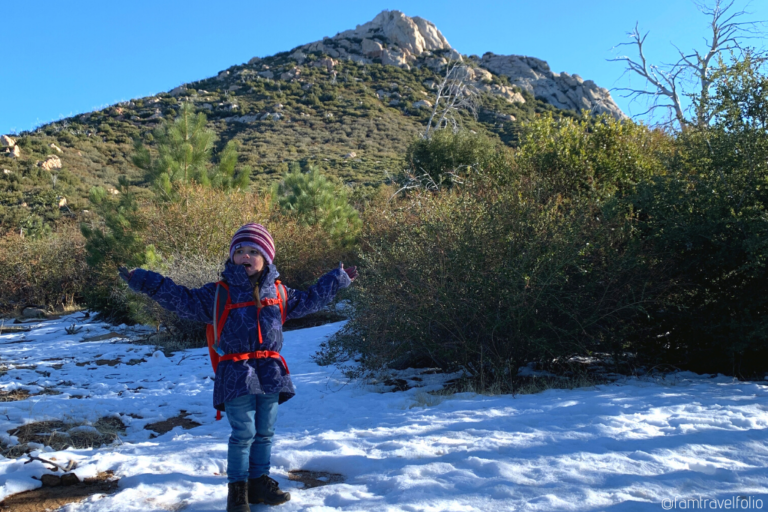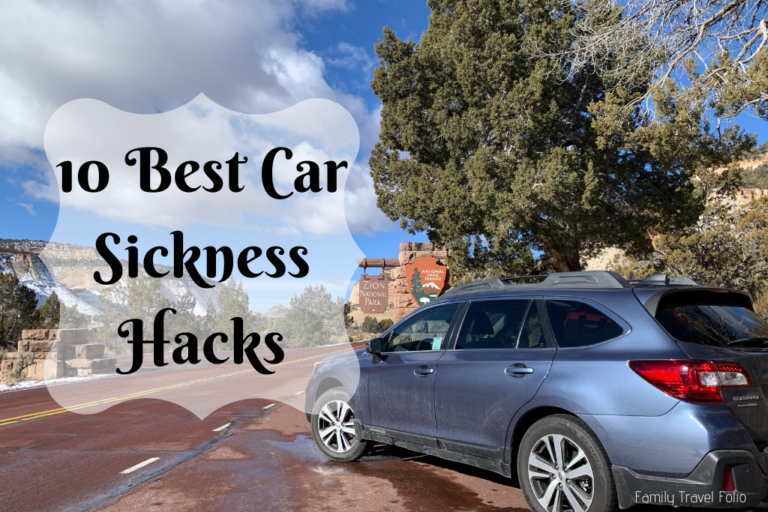Ultimate Family Guide on How to Stay Warm in a Tent
Wondering how to stay warm in a tent?
Our first time camping in cold weather was with our 7-month-old and 3-year-old daughters. We were by a lake and it got into the 50s℉ at night. That may not seem too cold, but when you’re camping with the wrong gear, it’s freezing.
The girls were bundled up in layers under their fuzzy sleepers, but I did not have nearly enough layers for myself. We had to stop at a local store to get hand and feet warmers for the second night!
After that experience, we jumped into all the cold-weather camping research. Now that’s our favorite weather to camp in, and we’ve even done snow camping.
Here’s our research and experience with everything you need to know about staying cozy in your tent, from essential gear to tried-and-true tricks that keep our whole family comfortable.
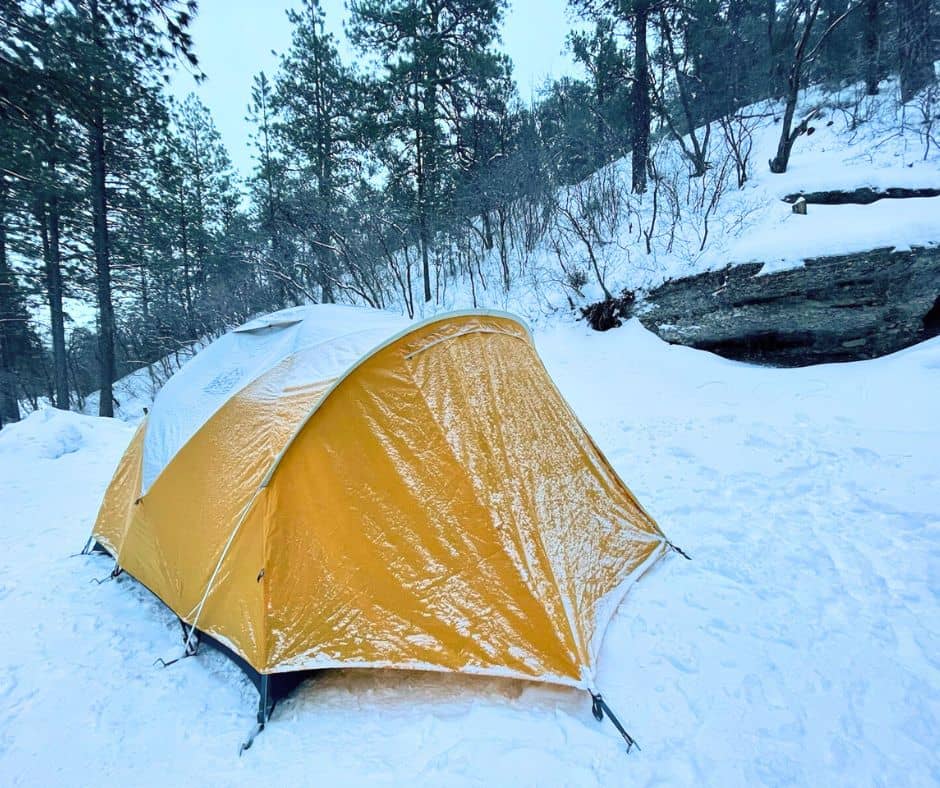
Cold Weather Tent Setup
The type of tent and where you pitch your tent make a huge difference in staying warm while camping! After freezing our buns off the first few times, we’ve learned some crucial cold-weather camping tips.
Let’s start with your tent. This was one of the big first mistakes we made- we had a spring tent that didn’t have a fly (the outer tarp that goes over a tent to help keep it dry and warm).
After that first cold-weather camping fail, we researched 3-4 season tents and came up with the REI Base Camp 6 Tent. They have since discontinued this exact model (which is a bummer because we absolutely love it!), but as long as you get a tent that matches your camping weather, you’re good.
For cold-weather camping, you’ll want either a 3-season tent with good ventilation and a full-coverage rainfly, or a 4-season tent if you’re camping in serious winter conditions. Don’t skip the footprint – it’s essential for keeping ground moisture from seeping in.
Whether you’re dealing with rain, snow, or wind, you need to select a site to pitch your tent as part of your strategy for keeping warm in cold temperatures.
Tips on Pitching Tent for Colder Weather
- Choose higher ground – cold air sinks into valleys
- Find natural wind barriers like trees or rock formations
- Position your tent where the morning sun will hit it
- If there’s snow, pack it down firmly before setting up
- Stake and set out your tent properly to prevent cold drafts
Camping in the Rain
A little hint if it’s been raining- don’t place your tent where the ground is still darker. Chances are this is where the rain pooled. We again learned this the hard way (in our defense, it wasn’t supposed to rain anymore, but it did. A lot.).
The rain pooled under our tents and our friend who had a 10-year-old camping tent actually had rainwater leak into it and got everything wet. We set out her camping mattress and sleeping bag to dry off and made room for her in our tent for the second night.
Place a tarp or a shade tent over your picnic table to have a dry place to sit and relax at camp. It can be fun camping in the rain, but if you’re wet all the time, you’re going to be cold and miserable.
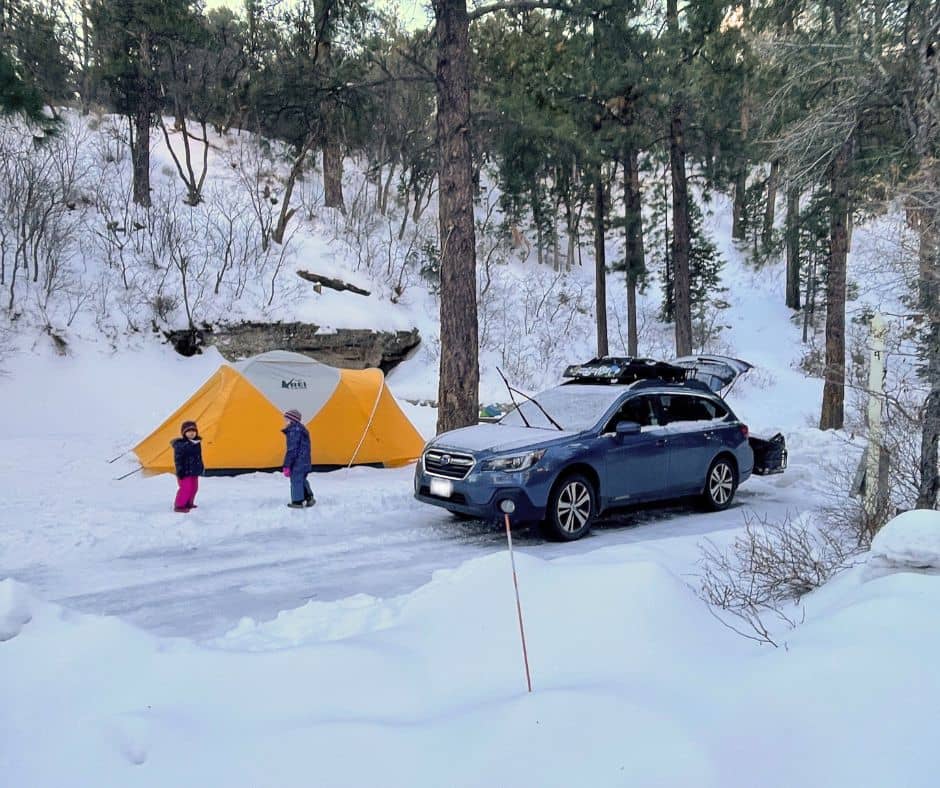
Camping in the Snow
There were only patches of snow on the ground in our first experience of snow camping, but the second time we were on a full blanket of snow and had to pack it down.
It wasn’t so hard, just using our water-resistant hiking boots to stomp out a rectangle of hard-packed snow. The hardest part was taking the tent down a couple of nights later- those poles were freezing! I used a hand warmer to run along the connections to help disconnect the pieces so we could fold everything up.
My only complaint about snow camping was not having a place to sit comfortably to eat. The picnic table had a layer of ice on the benches. Our camping chairs worked fine by the fire, but we didn’t bring a pop-up table.
Also, when snow camping, bring more socks than you think you need. We were sledding, got soaked, and the socks froze overnight so we kept on the socks we slept in. It worked, but dry socks on a very cold morning would have been appreciated instead of the ones we had on all night.
Sleeping Gear to Stay Warm Camping
The trick is your gear when trying to stay warm in a tent without electricity. We had sleeping pads for a cold camping night but didn’t know the R-value makes a difference in how well that mattress helps keep you warm.
Sleeping bags, and sleeping bag liners all have temperature ranges. You can custom-pick your sleeping gear depending on what camping weather you’re expecting.
The best decision we ever made was investing in proper camping mattresses. Not your typical household air mattress- those match the temperature of the air in the ground.
I’m talking about sleeping pads that use air and foam, built to insulate you in cold weather. Take a look at our favorites in this blog post.
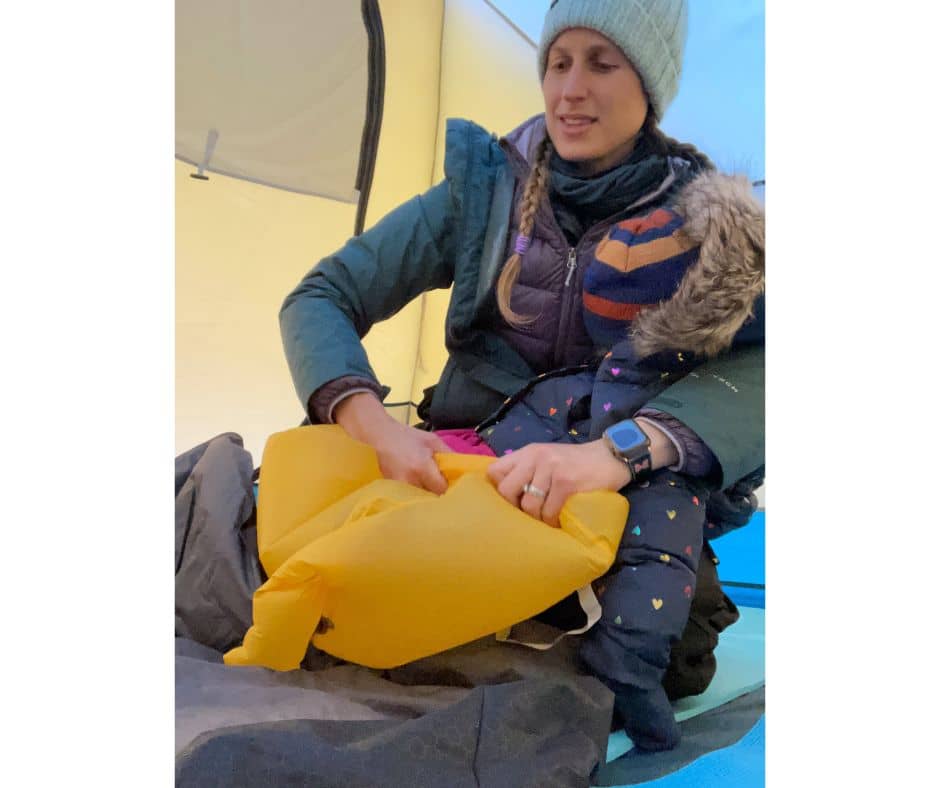
Essential Sleeping Gear for Cold Temperatures
- Camping Mattress/Sleeping Pad with an R-value of over 5
- Temperature Rates Sleeping Bag (get one rated 10°F lower than expected temperatures)
- Sleeping Bag Liner (adds up to 20°F of warmth)
- Insulated blanket inside your bag (we use a Rumpl down blanket)
Pro tip: putting a blanket on top of your sleeping bag doesn’t help much – the insulation needs to be inside where your body can warm it up!
Pro tip: Sleeping bag liners are also helpful for keeping your sleeping bag nice for longer. You can just wash the liner instead of the sleeping bag when you get back home.
Staying Warm with Clothing Layers
Layering is key for tent heating solutions, and everyone’s needs are different. Case in point: I bundle up like I’m heading to the Arctic while my husband barely needs an extra layer!
Wear layers, and adjust to your comfort level.
Layered Pajamas include a moisture-wicking base layer, insulated middle layer(s), weather-resistant outer layer, balaclava (full face mask), warm hat, gloves (+/- hand warmers), warm socks (+/- foot warmers)
Your base layer should be moisture-wicking so any sweat doesn’t make you colder. The mid-layer needs to be insulating such as fleece pajamas. The outer layer helps keep out the cold and traps all of your body heat.
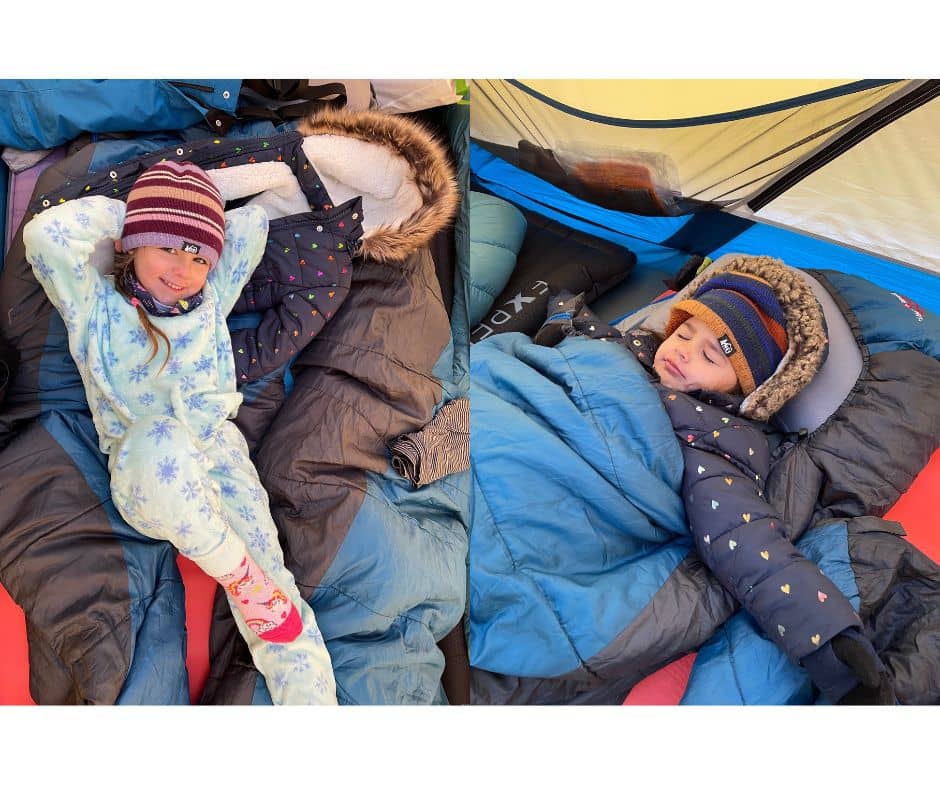
My cold-weather sleep system (because I get COLD):
Base layer: moisture-wicking thermal top and bottom
Mid layers: down pants, fleece pajama pants, down vest
Outer layer: the same weatherproof jacket and pants from daytime
Extremities: balaclava, beanie, double-layered gloves, wool socks
Extra warmth: hand and foot warmers (though I often remove these after warming up)
The kids’ setup (ages 7 and 4):
Base layer: moisture-wicking thermal top and bottom
Mid layers: cozy fleece pajamas
Outer layer: snow pants and weatherproof jackets
Extremities: warm socks, gloves, balaclava
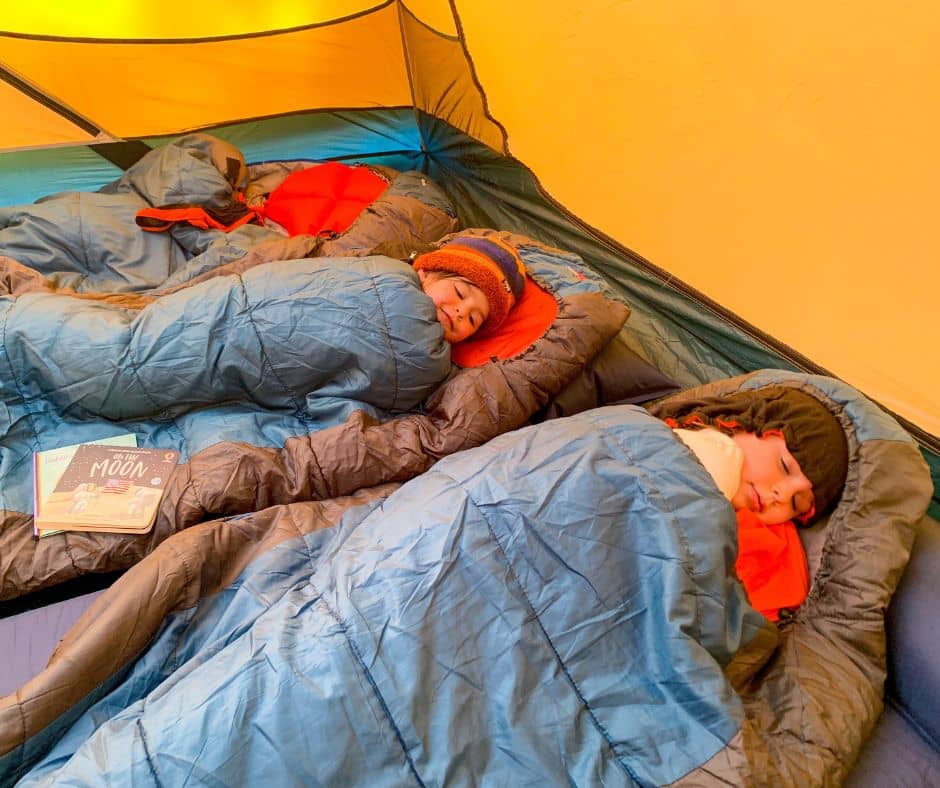
Before You Go: Cold Weather Camping Preparation
Learn from our mistakes! Use a family journal to keep track of the weather on your camping trips and write down what layers were not enough, too much, or just right.
You might need to play Goldilocks for a little while as you figure out what works best for your body type in different weather conditions.
We were really cold while camping in December by a lake → so we found out about R-Values on camping mattresses and invested in new ones to help against the cold.
We were wearing a lot of layers and still felt like we needed more → so we invested in Merino wool base layers (my grandma would be proud we’re wearing modern “long johns!”) to wick away moisture instead of our sweat keeping us cold.
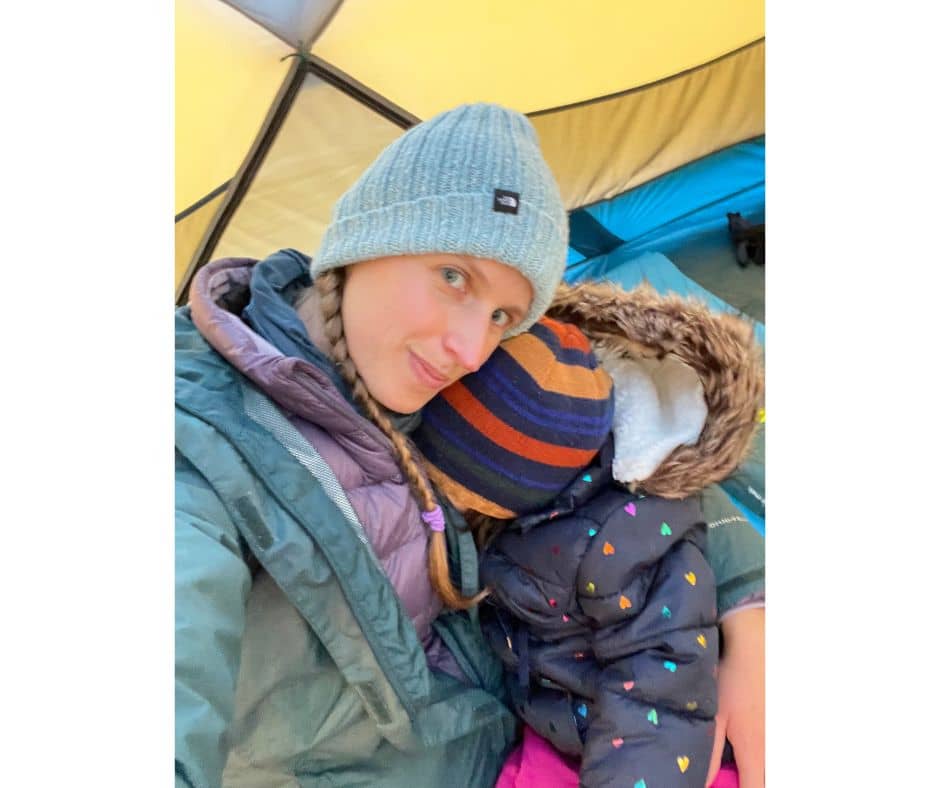
We didn’t feel our sleeping bags were helping → so we found sleeping bags made for colder temperatures and invested in sleeping bag liners.
Our socks were wet from sledding and froze over night making us wear our sleeping socks for the next day → so we now pack more socks than we think we’ll need
I think you get the idea. We’ve learned the hard way so hopefully, you can avoid some of these cold-weather camping mishaps and be snug as a bug in a rug inside your tent.
Before heading out for cold weather camping:
- Check weather forecasts obsessively (we use multiple sources)
- Test all gear in your backyard first
- Pack emergency warming supplies (extra hand warmers, emergency blankets)
- Charge all devices (cold drains batteries faster)
- Triple-check your packing list to make sure you didn’t forget any gear or layers
If you don’t have a packing list you can download mine for free:
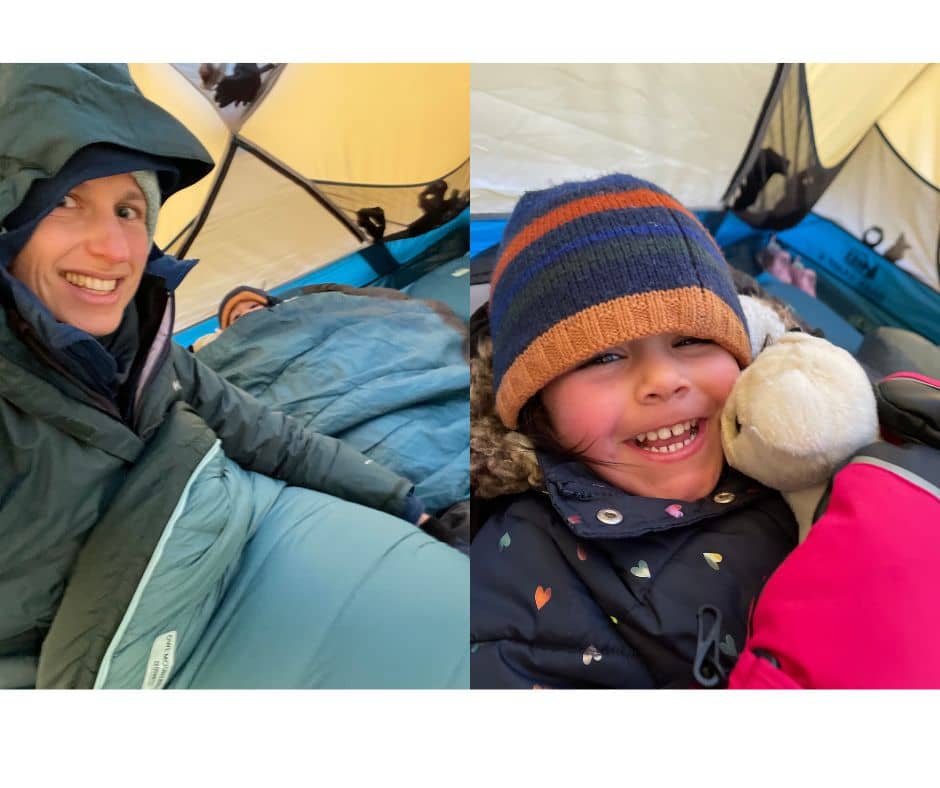
Morning and Evening Routine Tips
Getting dressed in freezing temps isn’t fun, but we’ve got it down to a science:
- Keep tomorrow’s clothes in your sleeping bag to warm them
- Change quickly in small sections (don’t strip down completely)
- Have a dedicated “changing area” in the tent
- Store boots in a waterproof bag to prevent overnight freezing
- Change any clothes that might be damp from night sweats
Normally socks you wear at night aren’t a problem to just keep wearing during the day, but we change them out for 2 reasons:
1) We don’t have Merino wool (or water-wicking) socks, so we don’t want any sweaty feet to keep our feet cold, and
2) We typically use the same socks at night multiple nights in a row and don’t want the dirt and mud from outside in our sleeping bags.
Worst case scenario: turn on your car and warm up with the car heater. This helped us immensely when we had a crabby morning from being cold after changing into daytime clothes. Seriously warm and snug all night long until we had to get dressed in the morning.
…I guess you could also sleep in until the day warms up a little more, but we’re early risers. It’s nicer to hit the hiking trails before other people and hit the road before any traffic.
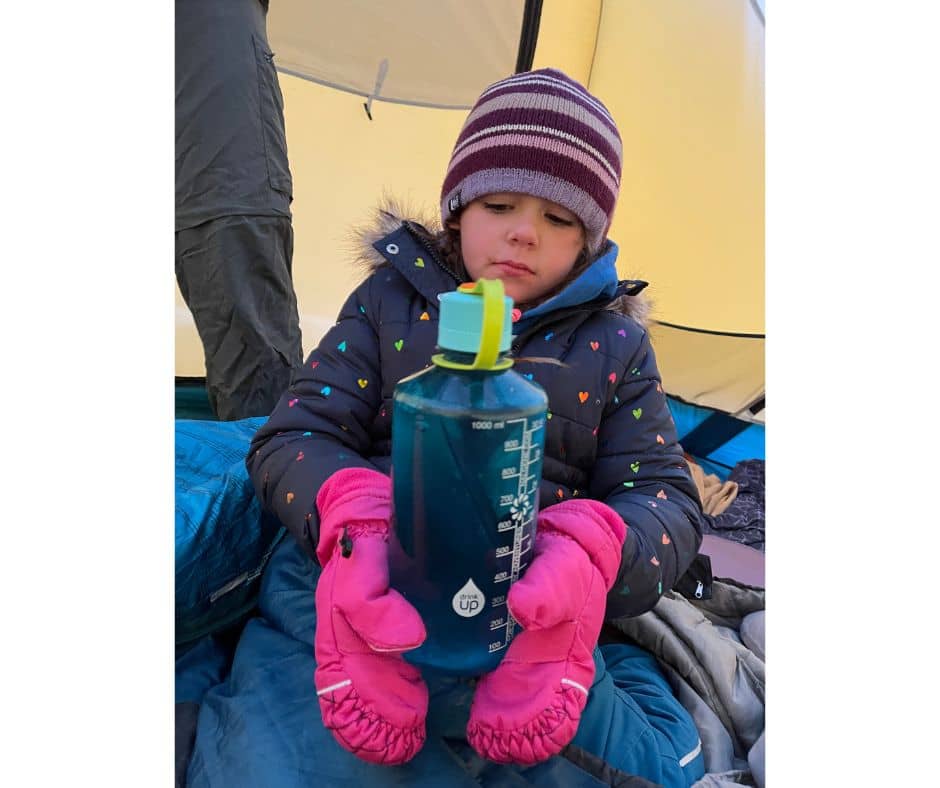
Cold Weather Camping Hacks
There are extra hacks you can use to warm up while in the tent or before turning in for the night or to warm up in the morning. We tried out a few and they do help!
There is also specific gear that can make cold-weather camping way easier, and dare I say fun!
Here’s what we’ve found works…
10 Ways to Stay Warm Camping
- Fill a Nalgene with hot water for a tent heater (wrap in a sock and toss it in your sleeping bag)
- Warm up with hot drinks (our kids’ favorite camping tradition is hot chocolate before bed)
- Eat a warm dinner and snack before bed – digestion generates heat (Instant oatmeal is a good cold-morning breakfast!)
- Use hand warmers strategically in pockets and sleeping bags
- Keep electronics warm by storing them in interior pockets
- Manage condensation by venting your tent (seems counterintuitive, but trust me!)
- Exercise before bed, but not to the point where you sweat (we do 5-10 squats by the campfire)
- Add a down blanket (like Rumpl!) into your sleeping bag to increase insulation (this is in addition to a sleeping bag liner)
- Invest in a heated sleeping bag liner (think electronic blanket, but better)
- Put on your base layers before the sun sets (basically bundle up before you start to get too cold)
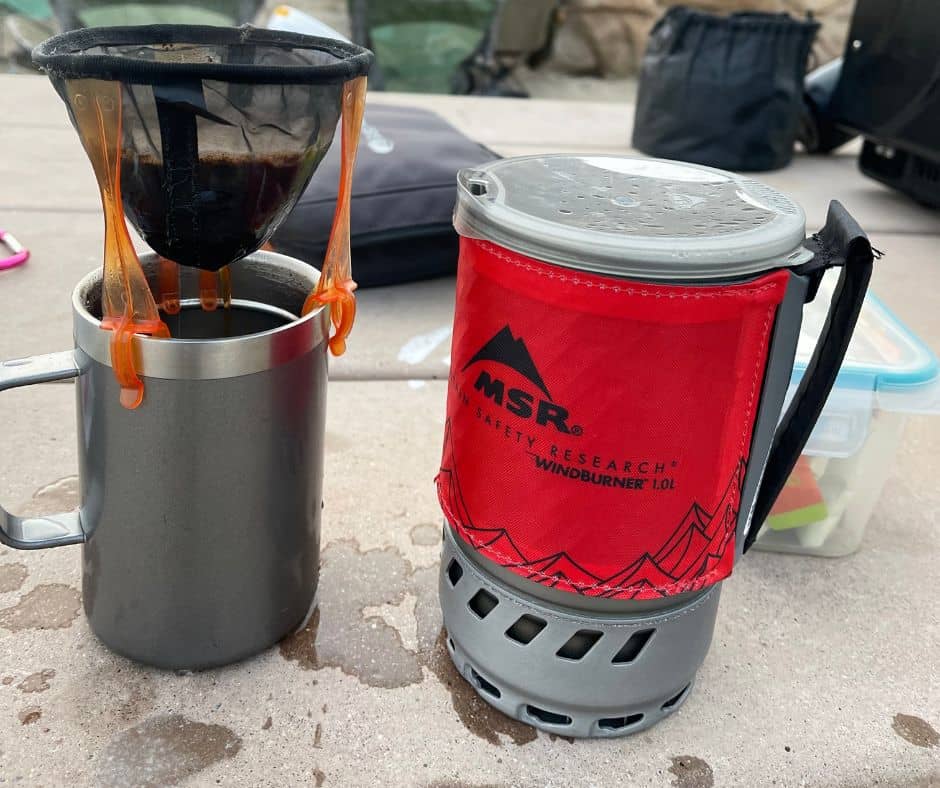
Cold Weather Camping Extra Gear
- Microspikes or crampons for icy conditions
- Snowshoes for deep snow
- Hiking poles for stability
- Extra layers in your pack (weather can change quickly)
This gear is in addition to your sleep setup and layered clothes we already talked about. Hiking trails in snow or icy conditions can be fun if you’re prepared.
How to Stay Warm in a Tent Summary
Our first time camping in the snow, we were one of 2 tents, everyone else had RVs. And everyone was shocked we were camping in a tent in the snow with little kids.
The other tent quickly left (their tent was not built for cold weather, and I’m sure they were missing a lot of other layers and a proper sleep setup).
We were perfectly warm all night long! And had an amazing time on stunning hikes, sledding at our campsite, drinking hot chocolate, and playing cards in the tent.
Camping in winter to me means no bugs, a quiet and peaceful atmosphere, and unique experiences.
My point? Don’t shy away from camping in colder weather, just consider these tips. If you know how to stay warm in a tent overnight and have the right hiking gear to help you explore, you will fall in love with camping in the cold!
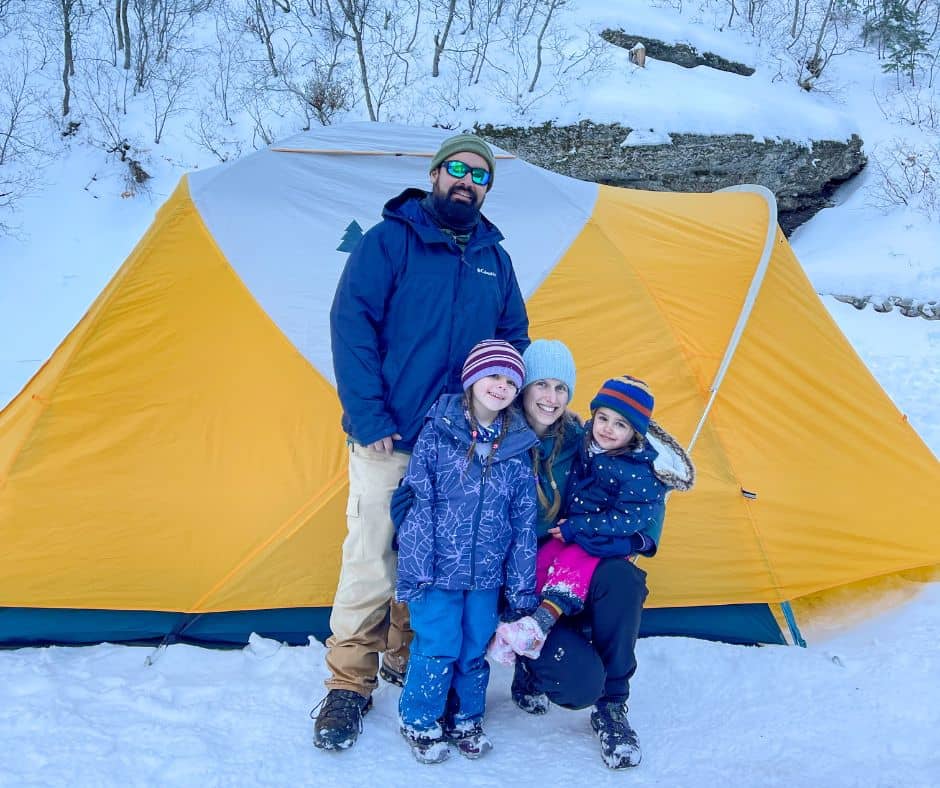
Camping Terms
Here are some terms I was not familiar with when I first started camping in the cold (well, camping more often in general really). Chances are if you’re looking up how to stay warm in a tent, you’re a bit newer to camping at might not know them (like me).
If you do know all about these camping terms and were just looking for extra tips you may not have known about staying warm in your tent, I hope you found something new and useful from our experiences!
Send me a message on Instagram with any extra questions or a tip I may not have covered.
Happy Adventures!
~Katie
Fly
A waterproof outer layer of a tent designed to protect against rain, wind, and other elements. Often referred to as a “rainfly,” it is typically removable and provides an additional layer of insulation and weather resistance.
Footprint
A groundsheet or tarp placed underneath a tent to provide extra protection for the tent floor. It helps prevent wear and tear from rough surfaces, reduces moisture seepage, and can increase the tent’s lifespan.
R-Value
A measure of insulation in sleeping pads or mats, indicating how well they resist heat loss. The higher the R-value, the better the insulation, making it suitable for colder conditions.
Balaclava
A close-fitting, head-covering garment that leaves only part of the face exposed, such as the eyes, nose, or mouth. Balaclavas are commonly used for warmth in cold weather, wind protection, or as a lightweight layer under helmets for activities like camping, hiking, skiing, or mountaineering.

